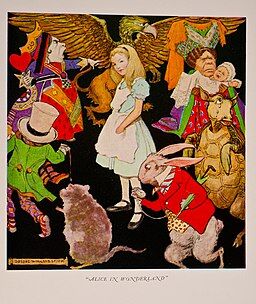Memory
"Still Alice": An Extraordinary Account of Alzheimer's Disease
Lisa Genova’s novel depicts Alzheimer’s from the viewpoint of the afflicted.
Posted April 20, 2022 Reviewed by Davia Sills
Key points
- Lisa Genova's novel "Still Alice" gives a sense of what if feels like to suffer from Alzheimer's disease.
- Genova uses the literary technique of focalization to tell the story from Alice's point of view.
- The novel is likely to be enlightening to family members and other people close to Alzheimer's sufferers.

In Lisa Genova's novel Still Alice, Alice Howland, a professor of psychology at Harvard, develops early-onset Alzheimer’s at the age of 50. She begins to suspect that something is wrong when she returns from her daily run and can’t remember the way home. Although she is mere streets away, everything suddenly looks unfamiliar.
The scene pulls back into focus, but this is not the usual kind of forgetting that we all occasionally experience. Up until this point, Alice has been experiencing the first stages of the disease—mild cognitive impairment—which can be nearly indistinguishable from the cognitive decline that accompanies aging or stress. She has been sufficiently functional to carry on with her life, including her teaching and research. But when the diagnosis is confirmed and Alice and her husband John break the news to their children, her daughter Lydia observes that she has been noticing Alice’s forgetfulness throughout the past year.
The novel’s brilliant innovation is to tell the story through Alice’s eyes using a technique that literary critics call focalization. There is a third-person narrator—there needs to be to let us know basic information that Alice can’t communicate—but this narrator tells events from Alice’s viewpoint. This technique vividly conveys the saddest aspect of the disease: the forgetting of loved ones, along with, of course, the memories of a lifetime. Reading about the disease from the point of view of the afflicted might well help family members to viscerally access what they know cognitively about the condition.
Genova shows the progression of such forgetting, tracing how the decline in Alice’s cognition can be seen in her deteriorating ability to remember and recognize people. Relatively early on in the disease, she fails to remember a person she was introduced to within the past half hour at a party. As she enters the middle stage of the disease, she still knows who people are, but she forgets the layout of her home, as well as the names of familiar objects, as in calling cream cheese “white butter.” Such details add painful authenticity.
Alice knows that “being sure of anything these days was tattered with too many holes to contain the meaning that it used to.” At this point, she also forgets that her sister died decades ago in a car accident, and when she finds out, she becomes enraged with her husband, John. “Why isn’t he upset too? He’s known about this for a while, that’s why, and he’s been keeping it from me. She couldn’t trust him.” Here, we see the rage and paranoia that also characterize Alzheimer’s.

As Alice deteriorates, the narrative captures the nuanced stages of the process, the way that memory incrementally erodes. “Alice knew that the young woman sitting across from her was her daughter, but she had a disturbing lack of confidence in this knowledge.” Soon, she no longer remembers who people are, although she retains flickering awareness of her loss of memory, as well as of the memories themselves: “'What time is it?' she asked the man sitting in the other big white chair.” The man is her husband. And when she has a lucid moment and realizes who he is, “she wanted to tell him everything she remembered and thought but she couldn’t send all those memories... past the choking weeds and sludge into audible sound.” The image mirrors the tangles of tau that characterize the disease. By the end of the novel, a mere two years since she lost her way when out for a run, Alice doesn’t recognize her family at all.
Despite the stunning accuracy of portraying what Genova calls the “essence of Alzheimer’s,” the novel ultimately undermines its dedication to truthfulness. At the end of the novel, Lydia, who is an actress, asks Alice to listen to a monologue. When Lydia asks her mother what she felt on hearing it, Alice replies, “I feel love. It’s about love.” Lydia is thrilled, “The actress squealed [Alice’s viewpoint], rushed over to Alice, kissed her on the cheek and smiled, every crease of her face delighted: Alice asks, 'Did I get it right?' and Lydia happily responds, 'You did, Mom. You got it exactly right.'" This accords with Genova’s second agenda, to show that “as the disease worsens and continues to steal pieces of what she’d always thought of as her self, we see her discover that she is more than what she can remember.”
But in the end, the self—identity—consists precisely of what we can remember. By “remember,” I include not only explicit memory systems but implicit ones as well, including procedural memory (how to do things) and emotional memory. The novel ends on a positive note, as positive as it can be given Alice’s condition, only because it has not yet progressed to the inevitable bitter end of the story. Alice still retains emotional memory in the novel's last scene, but at a time in the near future, Alice will not be able to give an accurate account of the effect conveyed by Lydia’s monologue.

If the name “Alice” sounds old-fashioned and Victorian to you, that’s probably because it is not a popular name today, and the most famous Alice was a Victorian, the heroine of Lewis Carroll’s novel, Alice in Wonderland. Carroll’s Alice travels to a land of wonder, where magic potions make her grow larger and smaller, talking animals have tea parties, playing cards come to life, pigs turn into babies, and cats disappear, leaving only their smiles behind them.
The decline into Alzheimer’s—we use a metaphor of descent, like falling down a rabbit hole—also brings people to a strange new land, but this is a land of “how": Alice’s last name, also unusual, is Howland. Alzheimer’s de-familiarizes the world, sending people to a strange “land” where they often have to ask “how” and to use all the question words much more frequently: How do I tie my shoelaces? Where is the bathroom? What day is it? Why is this happening to me? Who is this person who seems familiar but I don’t recognize? Who am I? Alice has indeed entered the land of “how,” a nightmare “wonderland,” but one with no eventual return. But despite Genova's attempt to find something redemptive in a disease that has no redemptive qualities, Still Alice offers a brilliant account of Alzheimer’s and what it feels like to lose yourself, gradually and relentlessly.
References
Genova, Lisa. Still Alice. New York: Simon and Schuster, 2007.
"A Conversation with Lisa Genova" in Still Alice. New York: Simon and Schuster, 2007.
Routledge Encyclopedia of Narrative Theory, ed. David Herman, Manfred Jahn, and Marie-Laure Ryan. New York: Routledge, 2007.




